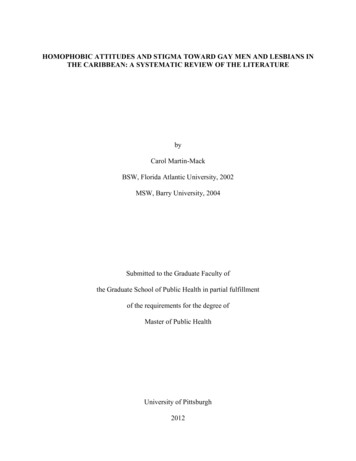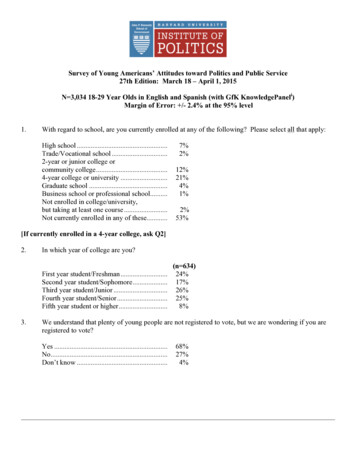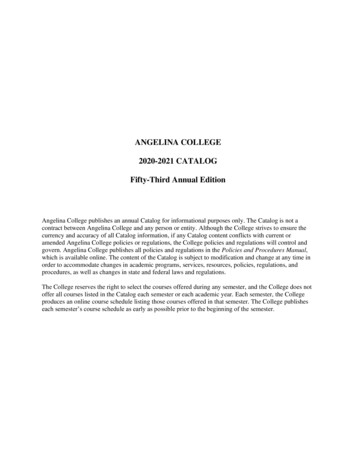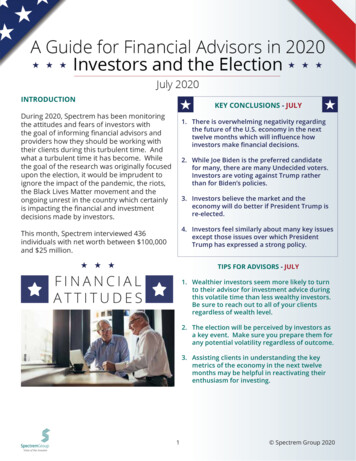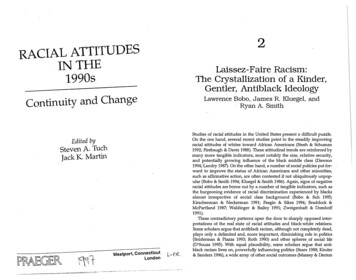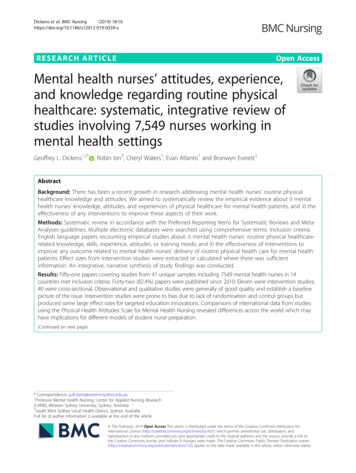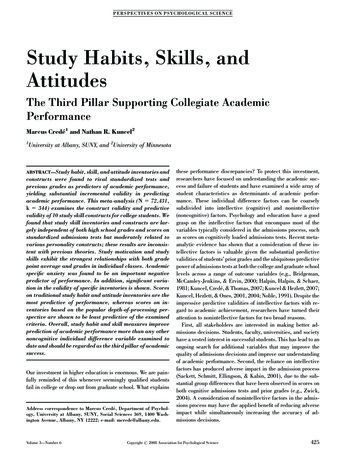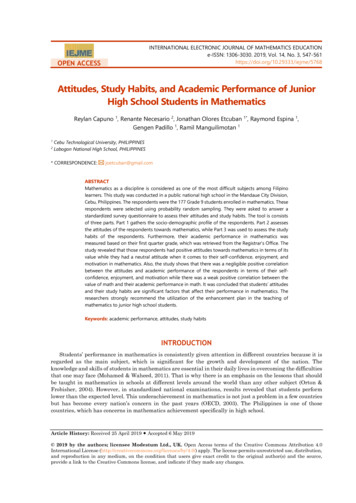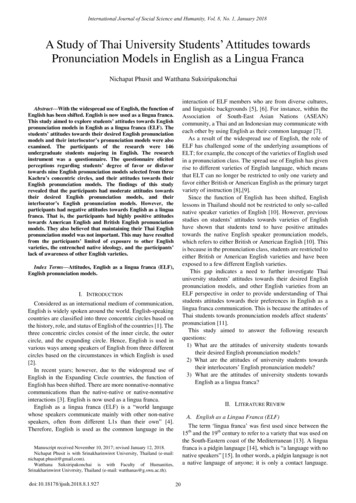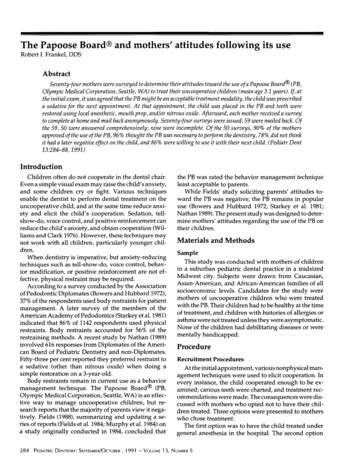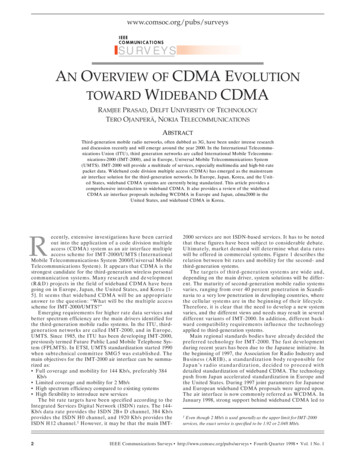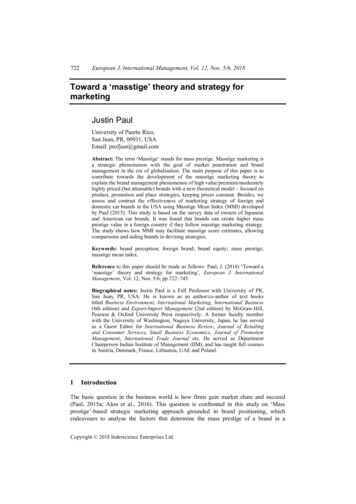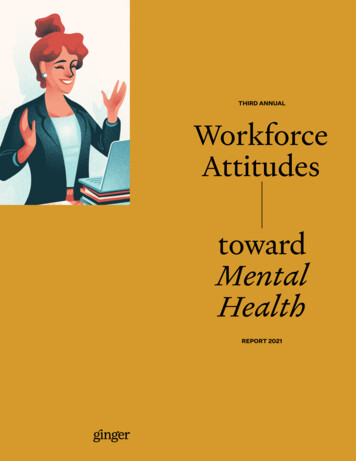
Transcription
THIRD ANNUALWorkforceAttitudestowardMentalHealthREPORT 2021
p. 2Ginger Workforce Attitudes 2021
Contentsp. 3A letter from Russ Glassp. 4p. 5Goals and Methodologyp. 6Definitionsp. 7Four keymessagesp. 10Optimismp. 13The impact on businessp. 18The awareness gapp. 22Virtual mental healthcarep. 27What leaders can dop. 29Demographicsp. 31AboutGinger Workforce Attitudes 2021
An Introductionp. 4When the COVID-19 pandemic began last year and the Ginger workforcewent fully remote, it quickly became clear to me that one of our top priorities wasto support our employees’ mental health needs. Our leadership team wanted toensure that our employees, as they faced the loneliness of working from home orthe stress of remote school for their children, knew that we were there for them. Weimplemented new policies and benefits to support our employees, like monthly selfcare days, increased wellness benefits, and an external mental health coach. As CEO,I was proud of the way we stepped up to provide our employees with extra support.But, even as a health technology company, we spent significant timesolving for the “last mile” challenge: effectively communicating to employees all thatwas available to them.When we performed our research this year with both CEOs and theaverage U.S. worker, we saw the “last mile” challenge show up across the board—intheir beliefs and their experiences with mental health.Fundamentally, excutives and employees agree mental health is animportant issue that employers should support. However, there's a significant gapbetween CEO and employee perceptions of available mental health benefits. Ourresearch showed, 96% of CEOs believe their companies are doing enough for employeemental health, yet only 69% of employees agree.In this year’s report, we offer solutions to bridge the awareness gap betweenCEOs and employees. As I am learning through my own experience as CEO of amental health company, we can offer incredible mental health and wellness benefits,and I know that they’re only effective if employees are using them.Our research found that both employees and CEOs are overwhelminglyoptimistic about the future. I take comfort in this finding and share this sentiment asI look forward to the year ahead in which we advance closer to Ginger’s own missionof a world where mental health is never an obstacle.Russell GlassCEO, GingerGinger Workforce Attitudes 2021
Goals andMethodologyp. 5In February 2021, Ginger partnered with DimensionalResearch to survey 1,229 employees in the United States acrossa variety of industries, demographics, and work types, includingknowledge, service, and manual workers. All those surveyedwere employed for 30 hours a week or more at jobs that includedbenefits. The survey asked a wide range of questions aboutexperiences with mental health and employee benefits. Thesurvey was fielded from February 8th to February 16th, 2021.To enable trend analysis, certain questions were repeated fromsimilar 2019 and 2020 surveys.Following the employee survey, Ginger and DimensionalResearch surveyed 158 U.S. business leaders, all of whom wereemployed as CEO, president, or equivalent business leaders at acompany that offers job benefits and has at least 100 employees.This survey was fielded from February 17th to February 23rd,2021. Some questions from the employee survey were repeatedto enable comparison. Leaders were also asked about theirexperiences with mental health and about their company’smental health benefits for employees.Ginger Workforce Attitudes 2021
Definitionsp. 6How do you define "mental health support?"“Mental health support” as defined in the study includesa wide spectrum of activities, from mindfulness practices andcoaching to formal mental health services from a therapist orpsychiatrist. Participants were given this definition of mental healthand were required to acknowledge the definition to participate.What is Ginger?Ginger makes it easy for employees to get the support theyneed, when they need it, with on-demand mental health coaching,video therapy and psychiatry, and self-guided skill-buildingactivities and exercises.What is Dimensional Research?Dimensional Research provides in-depth market researchto help technology companies make smarter business decisions.Ginger Workforce Attitudes 2021
p. 7Four key messagesfor employersGinger Workforce Attitudes 2021
1Employees and CEOs are optimistic aboutthe future.While 2020 was a year of anxietyand uncertainty, 2021 is proving to bea year of optimism. Last year, 70% ofemployees reported feeling more stressdue to the COVID-19 pandemic than everbefore in their professional careers. In2021, while 58% of employees agree thatCOVID is still a top stressor at work, 95%of employees are feeling optimistic about2p. 8life returning to “normal” and are lookingforward to in-person visits with friendsand family and opportunities for personalgrowth. Furthermore, of employees whohave been working from home due to thepandemic, 99% report that their mentalhealth has benefited from their workfrom-home situation.CEOs overwhelmingly believe that employees’mental health impacts business outcomes.Last year, COVID-19—and theensuing lockdowns, social distancing,and work-from-home situations—exacerbated the existing mental healthcrisis in the U.S. As a result, however,the pandemic shined a spotlight onthe importance of mental healthcare,especially in the workforce. Due to thepandemic, nearly all CEOs surveyedreport investing in their own mentalhealth, with 94% of CEOs receivingmental health support for themselves,and focusing more on mental health attheir companies. CEOs also recognizethe impact that employees’ mental healthcan have on work, with 80% believingthat poor employee mental healthnegatively impacts employee productivity.Meanwhile, 95% of employees report thatmental health support helped them feelmore positive, less stressed, and moreproductive at work. As one employeeshared, “It made me very productive toknow employers cared If I am valued, Iwant to offer that back.”Ginger Workforce Attitudes 2021
3There’s a disparity between CEOs andemployees when it comes to believingthat companies do enough to supportmental health.Many companies have investedin mental health benefits, and yetemployees aren’t sufficiently aware ofthem. In fact, 96% of CEOs think they aredoing enough for employee mental health,yet only 69% of employees agree. Andwhile 70% of CEOs say they’re acceptingof emotional and mental health issues inthe workplace, only 35% of employeesbelieve this is true. Not only do CEOsreport their companies are accepting ofdiscussions about mental health, they’retalking about their own mental health,4p. 9too. Of the CEOs who do talk about theirmental health, more than half report thatdoing so makes them a better leader. Andyet, while CEOs say that they’re talkingabout mental health (and their companiesare focusing on it more), not all employeessee it that way. The more senior theemployee, the more likely they are to viewtheir company’s support of mental healthpositively. Individual contributors reportthat their companies offer mental healthbenefits only half as often as CEOs do.CEOs and employees continue to experiencehigh-levels of stress and are increasingly relyingon technology-based mental healthcare for help.As stress levels among employees continue to rise, employees areturning to technology-based mentalhealthcare for support more and more.This year, 48% of employees reportexperiencing high or extreme stressover the past year—a 7% increase frompre-pandemic levels in 2019. Meanwhile,use of technology-based mental healthservices has increased from 29% at thebeginning of 2020 to 48% in 2021. Useof mental health benefits overall (bothvirtual and other) has increased 39% overthe last year. In fact, more than threequarters of employees who worked with amental health professional did so virtuallyin the past year, with executive, skilledworkers, and employees with caregivingresponsibilities preferring virtual mentalhealth support the most.Ginger Workforce Attitudes 2021
p. 101Vaccinations.Fewer lockdowns.Visits with friendsand family. Hopefor the future.Ginger Workforce Attitudes 2021
95% of employees are optimisticabout 2021.p. 11When you think about 2021, what givesyou optimism?Potential of life becoming more “normal” (vaccinations, fewer54%lockdowns, etc.)52%Looking forward to visiting family or friends that I have notbeen able to see because of COVID-1942%Have plans for personal growth in 2021 (education, travel, etc.)38%Less political drama since it is not an election yearExpect to celebrate a life milestone (birth of a child, marriage,33%graduation, major birthday, etc.)1%OtherI am not optimistic about 20215%0%In general, how has working from homesince the onset of COVID-19 impactedyour mental health?20%40%60%While COVID-19 has beenstressful, working from home hasbeen a positive experience formost employees.Mostly positiveNo difference15%Mostly negative18%68%Ginger Workforce Attitudes 2021
99% of employees benefited fromworking from home because ofCOVID-19.p. 12What parts of working from home duringCOVID-19 do you find helpful for your mentalhealth?52%Spend more time with my family or petsI have more time for myself49%Can easily take little breaks to get my energy up48%No commute48%42%Appreciate the privacy when I have a difficult momentEasier to exercise and eat right40%Less office politics36%1%Nothing about working from home is good for my mental health0%How has COVID-19 impacted your ownmental health?10%20%30%40%50%60%63% of CEOs report thatCOVID-19 has been positivefor their mental health.Mostly positiveI've been energized by having newbusiness problems to solve orappreciated changes related to workfrom-homeMostly negativeI'm more anxious, burnt out, orgenerally stressed32%It hasn't had an impact63%4%Ginger Workforce Attitudes 2021
p. 132“It made me veryproductive toknow employerscared If I amvalued I want tooffer that back.”Mental healthimpacts business.Ginger Workforce Attitudes 2021
CEOs see productivity as thetop concern when it comes toemployees’ mental health.p. 14As a business leader, what concerns do youhave about employee mental health?Impact on productivity80%69%Personal concern for employee wellbeing59%Potential for risky situations with an employee having a mentalhealth crisis40%Reputational risk if behaviors become publicDifficult to implement strategies if team members cannot berelied on37%1%I don't have any concerns about employee mental health0%In the past year, have you received anymental health support?10%20%30%40%50%60%70%80%90%CEOs are far more likely thanemployees to receive mentalhealth support.CEOEmployee53%Self-guided mindfulness or wellbeing app24%43%Behavioral health coach21%41%Community counselor or peer support group20%41%Psychologist or licensed therapist29%Psychiatrist, or prescription for psychiatric help35%26%I have not done any of these6%37%0%10%20%30%40%50%60%Ginger Workforce Attitudes 2021
How has your company's focus onemployee emotional and mental healthchanged as a result of COVID-19?92% of CEOs say that theircompanies are more focusedon mental health because ofCOVID-19.Increased focusp. 15Decreased focusNo changeCEO92% 4% 4%Employee57%33%10%57% of employees report thattheir company’s focus on mentalhealth has increased as a result ofCOVID-19.How has your company's focus onemployee emotional and mental healthchanged as a result of COVID-19?Increased focusDecreased focusNo change2020 (COVID-19)202153%33%57%33%14%10%Ginger Workforce Attitudes 2021
More than half of CEOs say that talkingabout their own mental health makesthem a better leader.p. 16What motivates you to speak to youremployees or staff about your own emotionaland mental health?It helps me be a better leader58%It gives permission to other employees to admit they need help42%It helps to build a sense of community among my team40%Leaders should talk about things their teams care about, andmy team cares about mental health35%It's a topic that comes up sometimes so I participate30%6%Nothing would motivate me to speak about mental health0%What holds you back from talking aboutemotional and mental health with your team?10%20%30%40%50%60% but CEOs also hold back fromtalking about their mental healthbecause of concerns it will impacttheir credibility and employeeconfidence in them.56%Concern it will impact my credibility as a leader44%Employees will lose confidence34%Share price or investor confidence might be impacted15%I have nothing to say14%I've never thought about itI don't have emotional or mental health issues to discuss13%I don't feel qualified to discuss the issues13%Nothing holds me back8%0%20%40%60%Ginger Workforce Attitudes 2021
88% of employees appreciatewhen their company’s leaders talkabout their own mental health.p. 17How do you feel about your leaders speakingabout their emotional and mental health?I appreciate itI wish they wouldn'tI don't care either way2020202187%88%5%5%7%7%Ginger Workforce Attitudes 2021
p. 183CEOs care aboutmental health.Employees aregetting a differentmessage.Ginger Workforce Attitudes 2021
94% of CEOs agree employeemental health is a C-suite issue.CEO: Please indicate your level of agreementwith each of the following statements.p. 19Strongly agreeDisagree somewhatAgree somewhatStrongly disagreeEmployee mental health is a C-suiteissue, not just an HR issue.61%33%3% 3%I find it easier to deal with work-related mentalhealth issues than mental health issues with my kids.60%29%8%31%7%2%I am concerned that my managers are putting their ownmental health at risk by absorbing the stress of their teams.59%3%I do care about the mental health of my employees,but practically, I don’t know what to do about it.62%23%10%5%69% of CEOs see themselves asaccepting of mental health issues.Only 35% of employees agree.Please indicate your level of agreementwith each of the following statements.Strongly agreeDisagree somewhatAgree somewhatStrongly disagreeCEO: As a business leader, I am more accepting ofemotional and mental health issues now than in the past.69%28%3% 1%Employee: My workplace is more accepting of emotionaland mental health issues now than in the past.35%44%14%7%Ginger Workforce Attitudes 2021
98% of CEOs say their company offers mentalhealth benefits. Meanwhile, 55% of individualcontributors say that their company does.CEO: Does your company offeremotional and mental healthbenefits to employees?p. 20Employee: Does your employeroffer emotional and mental healthbenefits?YesNoCEO98%2%Executive83%17%Team manager72%28%Individual contributor55%45%The bigger the company, the less likely employees are tothink their employer is doing enough for mental health.Employee: In your opinion, does your employer doenough to support your mental health?YesNoCompanies with more than 25,000 employees58%42%Companies with 5,001 – 25,000 employees64%36%Companies with 1,000 – 5,000 employees73%27%Companies with less than 1,000 employees70%30%Ginger Workforce Attitudes 2021
Individual contributors are nearly half aslikely as CEOs are to think their companiesdo enough to support mental health.CEO: In your opinion, does yourcompany do enough to support themental health of your employees?p. 21Employee: In your opinion, doesyour employer do enough tosupport your mental health?YesNoCEO96%4%Executive86%14%Team manager71%29%Individual contributor56%44%Ginger Workforce Attitudes 2021
p. 224Even with anoptimisticoutlook, stresslevels remain high,and employeesare turning totechnology-basedmental healthsupport.Ginger Workforce Attitudes 2021
Employee stress levels arestill high.p. 23Extreme stress (experience stress every day)How would you characterize the overalllevel of stress you have experienced withinthe past 12 months?High stress (experience stress most days)Moderate stress (experience stress at least once a week)Low stress (rarely experience stress)No stress201916%29%38%15%3%2020 (Pre-COVID-19)15%31%39%13%2%2020 (During COVID-19) This version of the question asked about overall stress "in the past 4-6 weeks"19%34%35%11%1%39%11%2%202118%30%Use of technology-based mental healthcare has jumped from 29% to 48% overthe past year.Have you ever used technology-based emotional ormental health services such as online counseling ormental health apps?YesNo2020 (Pre-COVID-19)29%71%2020 (During COVID-19) This version of the question asked about overall stress "in the past 4-6 weeks"38%62%202148%52%Ginger Workforce Attitudes 2021
76% of employees who receivedmental health support, did sovirtually.p. 24How did you receive mental healthsupport in the past year?A mix of both virtuallyand in-person26%Virtually49%24%In-personCEOs especially prefer virtual mentalhealthcare.Based on your recent experiences with virtualmental health support, what is your preferredway to work with a therapist?Virtual is the bestIn-person is the bestThere is no differenceCEO68%Employee52%15%5%26%33%Ginger Workforce Attitudes 2021
Executives and blue collar workersprefer virtual mental healthcare morethan other job roles and types.Based on your recent experiences withvirtual mental health support, what is yourpreferred way to work with a therapist?p. 25Virtual is the bestThere is no differenceIn-person is the bestJob LevelIndividual contributor25%26%49%Team manager52%14%33%Executive70%8%22%Type of WorkService worker38%27%36%Knowledge worker43%16%41%Manual worker71%5%24%Ginger Workforce Attitudes 2021
Employees with caregivingresponsibilities prefer virtual therapytwice as often as much as those withoutcaregiving responsibilities.Based on your recent experiences withvirtual mental health support, what is yourpreferred way to work with a therapist?p. 26Virtual is the bestThere is no differenceIn-person is the bestNot a caregiver28%22%50%Caregiver57%13%29%Nearly all employees and CEOs found that mentalhealth support helps them at work.Did the mental health support you receivedin the past year help you cope at work?YesNoCEO98%2%Employee (Employees offered slightly different question with several ways of help plus "no")95%5%Ginger Workforce Attitudes 2021
p. 27In ConclusionWhat leaderscan doGinger Workforce Attitudes 2021
1Invest in a mental health benefit if youhaven't already.p. 28Our research shows that employees appreciate—and expect—a mentalhealth benefit as part of their benefits package. Yet, traditional solutions such asemployee assistance programs (EAPs) only allow employees access to a limited numberof in-network providers, with long wait times that leave an employee’s mental healthuntreated while they wait. Virtual mental healthcare is now the norm. For the past threeyears employees have been increasingly turning to virtual care for their mental healthsupport—and research shows that it works to improve mental health outcomes. Offeryour employees an effective, convenient mental health benefit. It’s what they’ve come toexpect.2Communicate with employees effectively sothey’re aware of the mental health benefitsavailable to them.While almost all CEOs we surveyed are aware that their company offers mentalhealth benefits, only 55% of individual contributors say their company offers them. Thisgap either indicates an overstatement by CEOs, a lack of awareness by employees, orboth. If you’ve done the work to find the right mental health benefit, make sure employeesknow about that benefit. Develop a strong communications plan that connects mentalhealth to employees’ everyday needs—like sleep, tackling loneliness, and managingwork-life balance as a parent.3Encourage open discussion around mentalhealth, starting with leadership.Employees appreciate when leaders speak about mental health. Helpnormalize mental health support by speaking about your own struggles and self-care.Promote work-life balance through policies that support
However, there's a significant gap between CEO and employee perceptions of available mental health benefits. Our research showed, 96% of CEOs believe their companies are doing enough for employee mental health, yet only 69% of employees agree. In this year’s report, we offer solutions to bridge the a
